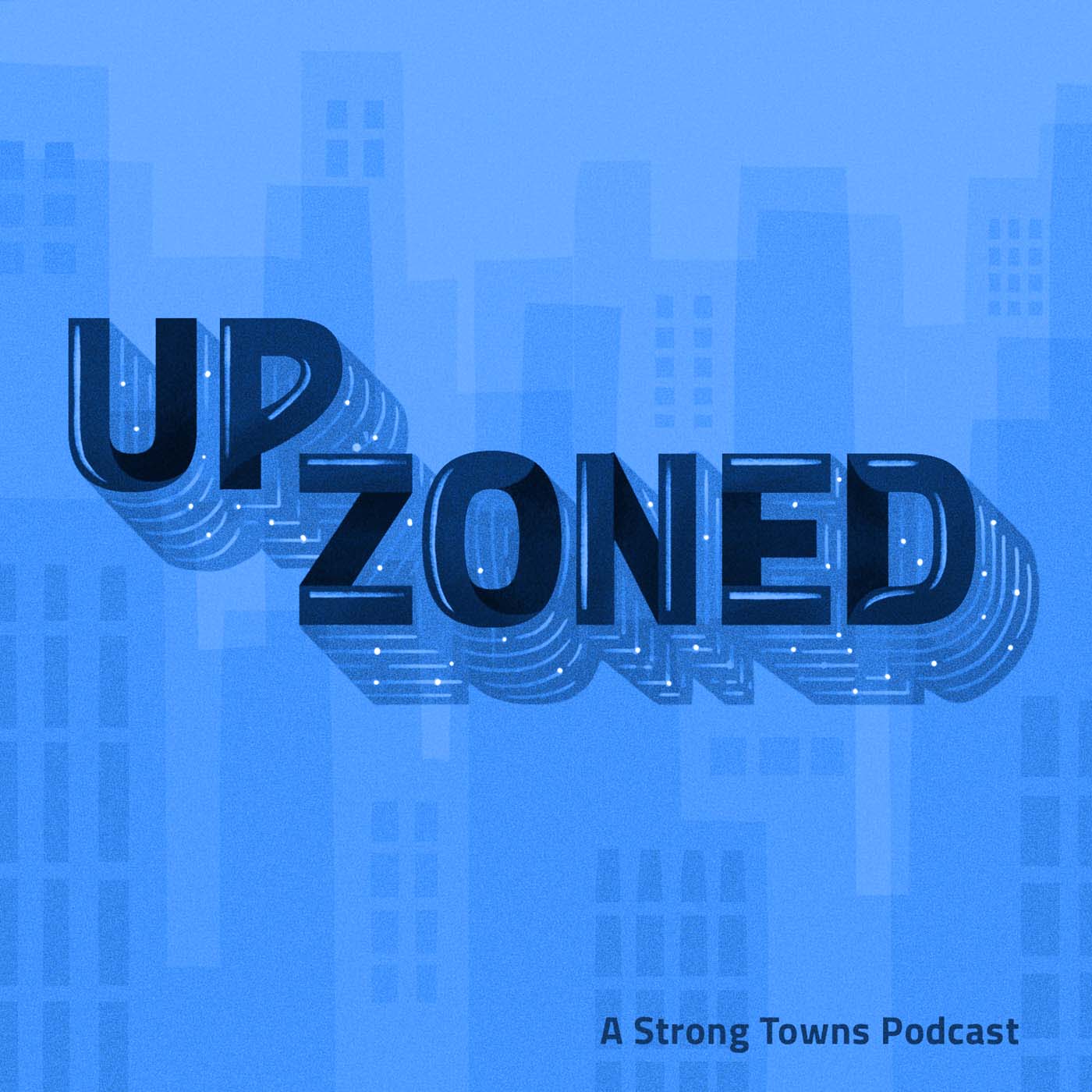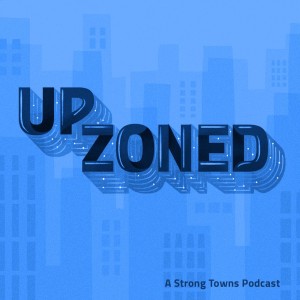
Sometimes, a hot new story will cross our desks that we need to talk about right away. That's where Upzoned comes in. Join Multistudio's Abby Newsham, Strong Towns President Chuck Marohn, and other guests to talk in depth about one big story from the week in the Strong Towns conversation, right when you want it: now.
Episodes

Wednesday Jan 25, 2023
The Governor of Missouri Wants to Spend $859 Million on Highway Expansion
Wednesday Jan 25, 2023
Wednesday Jan 25, 2023
The state of Missouri has a $6 billion budget surplus due to an increase in tax revenue and unspent federal aid. Governor Parson wants to use $859 million of it to expand I-70, the major transport route which connects Kansas City and St. Louis. This expansion would bulldoze through key areas in downtown St. Louis, areas west of downtown, and even the suburban areas of Columbia (which sits right near the middle of the interstate). Lots of people, even those unfamiliar with the Strong Towns perspective, think this expenditure proposal is a bad idea.
Today, join host Abby Kinney and co-host Chuck Marohn on the Upzoned podcast as they discuss this story and potential avenues for better spending.
ADDITIONAL SHOW NOTES
-
“Missouri Gov. Parson Wants $859M to Expand I-70. Here Are His Other Budget Priorities,” by Kacen Bayless and Jonathan Shorman, The Kansas City Star (January 2023).

Wednesday Jan 18, 2023
The U.S. Is Running Out of Skilled Labor. Is It Gen-Z’s Fault?
Wednesday Jan 18, 2023
Wednesday Jan 18, 2023
The U.S. is crying out, saying we NEED more carpenters, plumbers, and other people in skilled trades and technical industries—but the generation about to take over the workforce, Gen Z, doesn’t seem interested. As time presses forward, we’re continuing to see more open positions, and not enough people to fill them. This could impact not only agriculture, infrastructure, housing, and transportation, but everyone’s daily lives, in general.
The “shortage of workers” discourse tends to point a finger at Gen Z’s lack of work ethics, but in this episode of Upzoned, podcast host Abby Kiney and guest Daniel Herriges talk about variables that are often left out of the conversation.
ADDITIONAL SHOW NOTES
-
“America needs carpenters and plumbers. Gen Z doesn't seem interested,” by Mary Yang, NPR (January 2023).

Wednesday Jan 11, 2023
People Move to Places with Zoning Laws, Ergo Zoning Is Good?
Wednesday Jan 11, 2023
Wednesday Jan 11, 2023
In a recent Planetizen article titled, “Is Exclusionary Zoning a Good Thing?” author Michael Lewyn examines a theoretical argument presented by Judge Glock in the American Affairs Journal: that because people move to places that have zoning laws, zoning must be good. In this Upzoned episode, host Abby Kinney and co-host Chuck Marohn unpack the zoning debate between these two authors and how zoning is truly impacting cities.
ADDITIONAL SHOW NOTES
-
“Is Exclusionary Zoning a Good Thing?” by Michael Lewyn, Planetizen (January 2023).
-
“Two Cheers for Zoning,” by Judge Glock, American Affairs (Winter 2022).
-
“Small Developers and the Construction Labor Shortage—time to dig deep,” by R. John Anderson, R John the Bad (December 2021).

Monday Dec 19, 2022
Thanks for a Great Year
Monday Dec 19, 2022
Monday Dec 19, 2022
It's been a great year here on Upzoned; thanks for listening. We wanted to close out 2022 with one last message, and to wish you Happy Holidays and a Happy New Year!

Wednesday Dec 07, 2022
Homeowners Struggling to Get Insurance in Wildfire-Prone Colorado
Wednesday Dec 07, 2022
Wednesday Dec 07, 2022
An increasing risk of wildfires has made insurance carriers wary of certain areas in Colorado—according to a recent Denver Post article—raising their premiums and, in some cases, opting to not cover them, at all. In just the past few years, heavily forested areas of the state have been hit hard by wildfires. The Marshall Fire of December 2021, for instance, caused $2 billion in damages and has turned out to be the most expensive wildfire in the state's history.
Quite often, homeowners discover that they're underinsured when these things happen, meaning their insurance policies don't provide enough money to rebuild their homes once a fire occurs. In mountain communities like Aspen, Vail, Telluride, Steamboat Springs, and others, insurance companies are starting to pull out, altogether.
So, what are homeowners to do? Abby Kinney and co-host Chuck Marohn discuss the situation in today's episode of Upzoned.
ADDITIONAL SHOW NOTES
-
“Will insurance companies opt to leave Colorado?” by Noelle Phillips, The Denver Post (November 2022).

Wednesday Nov 23, 2022
These 3 Cities Are Eliminating Parking Minimums. Are They Going About It the Right Way?
Wednesday Nov 23, 2022
Wednesday Nov 23, 2022
It's #BlackFridayParking week at Strong Towns, which means we've got a special parking-related episode of the Upzoned podcast today. Host Abby Kinney, co-host Chuck Marohn, and special guest Edward Erfurt (director of community action at Strong Towns) come together to discuss three stories from three different cities—Burlington, Vermont; Nashville, Tennessee; and Cambridge, Massachusetts—all of which are taking big steps to eliminate parking minimums. And in some cases, the cities are even looking at establishing parking maximums!
Does it make sense for cities to have a blanket policy on parking, one way or the other? How can communities have these conversations about parking, especially when there are people—residents and developers alike—who argue and push back against parking reform?
ADDITIONAL SHOW NOTES
-
“Burlington may eliminate parking minimums for builders city-wide. Here are the possible effects,” by Lilly St. Angelo,
Burlington Free Press (October 2022).
-
“Bill to Eliminate Minimum Parking Requirements to Go Before Council,” by Connor Daryani, Nashville Scene (November 2022).
-
“Cambridge eliminates minimum parking requirements,” by Kaushar Barejiya, The Massmedia (November 2022).
-
Learn more about #BlackFridayParking.

Wednesday Nov 16, 2022
Why Is It So Expensive To Build Public Transit in the U.S.?
Wednesday Nov 16, 2022
Wednesday Nov 16, 2022
A recent VICE article shares the conclusions of a report published by an NYU research group. The research, led by Alon Levy, spans some 15 years and demonstrates the extent to which transit projects in the U.S. are inflated compared to other countries around the world—and what we can do about it.
For instance, the cost of constructing a subway in New York is double what it costs in Tokyo and 10 times what it costs in Paris. The research found New York to be the most expensive place to build transit in the world, and the lack of efficiency means we get less transit for more money, and we have a lot of public sector debt.
Why is this the case? Levy offers several reasons, which Abby and Chuck unpack in today's episode.
And by the way, it's Member Week at Strong Towns! We’re celebrating our members and everything that they do to make their communities stronger and more resilient. If you want to join this movement of a million local heroes, then do so by becoming a Strong Towns member today.

Wednesday Nov 09, 2022
This Man Overcame Homelessness by Building His Own Tiny Home…on Hollywood Boulevard!
Wednesday Nov 09, 2022
Wednesday Nov 09, 2022
An army veteran who was homeless in Los Angeles got tired of having his tent cleared out by the city's sanitation teams...so he decided to build his own house. By working with the community, the man, who goes by "Q," gathered the materials necessary to build a tiny home, complete with a generator and potted plants.
Q earns money fixing electric scooters and wants to start his own business, stating that he hopes to be an example for others in his situation. Given that, what can we learn from Q's housing solution, and from others who are responding to the housing crisis in unique—yet logical—ways?
Find out on today's episode of Upzoned, featuring host Abby Kinney and co-host Chuck Marohn!
ADDITIONAL SHOW NOTES
-
“Homeless Los Angeles man builds wooden house on Hollywood Boulevard sidewalk: ‘Gives me empowerment’,” by Louis Casiano, New York Post (October 2022).

Wednesday Nov 02, 2022
What Does the ”Airbnbust” Mean for the Housing Market?
Wednesday Nov 02, 2022
Wednesday Nov 02, 2022
There's been much speculation on the internet lately—to the point of almost becoming a meme—about whether we are witnessing the great "Airbnbust." In other words, people are saying that short-term rentals are a bubble that is popping right before our eyes.
As reported in Market Watch, many short-term rental owners are voicing concerns on forums like Reddit, Twitter, and Facebook about their bookings plummeting over the past three to four months. In some cases, hosts say they were at 80% occupancy, but now find themselves all the way down to zero.
At this point, it's not completely clear what's happening or why it's happening, but host Abby Kinney and co-host Chuck Marohn unravel what we do know on today's episode of Upzoned.
ADDITIONAL SHOW NOTES
-
“Airbnb hosts say bookings ‘fell off a cliff’ amid influx of new vacation rentals and rising prices,” by Levi Sumagaysay, Market Watch (October 2022).

Thursday Oct 27, 2022
This Seattle Highway Is Facing a $29 Million Financial Crisis
Thursday Oct 27, 2022
Thursday Oct 27, 2022
During the winter of 2019, a tunnel for State Route 99 (SR 99) opened, running beneath downtown Seattle, Washington. It was a long-anticipated project with a price tag of $3.3 billion—with an accompanying tolling program to cover $20 million in construction debt and operating costs.
The tunnel was toll-free for the first nine months after opening, so that drivers would be enticed to change their routes. However, only a couple of months after the tolling began, so did the COVID-19 pandemic. This drastically changed traffic patterns, and even now in fall 2022, traffic patterns have not picked up to 2019 levels.
Consequently, the tunnel is now facing what some call a "financial crisis," even after imposing an urgent 15% toll rate increase to make up for 2020 losses. In all, SR 99 is estimated to have a $29 million deficit right now—which podcast host Abby Kinney and Strong Towns Editor-in-Chief Daniel Herriges explore on this week's episode of Upzoned.
ADDITIONAL SHOW NOTES
-
“Fewer drivers in Seattle’s Highway 99 tunnel could create need for bailout,” by Mike Lindblom, The Seattle Times (October 2022).
